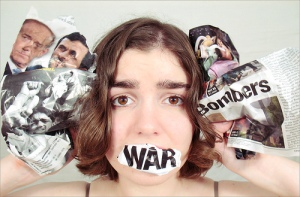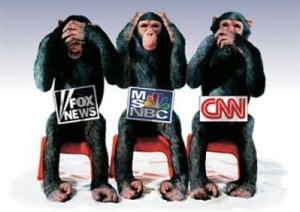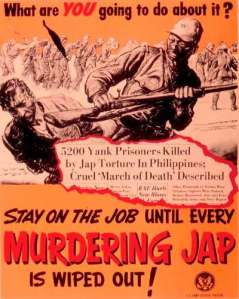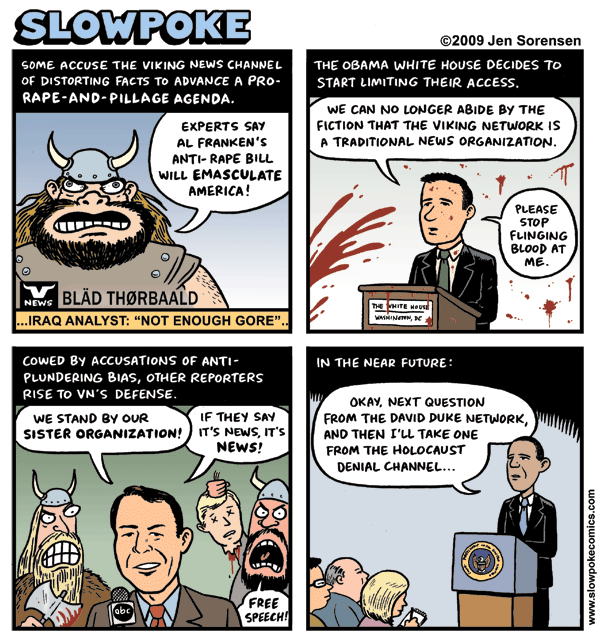By Mallory Meter and Jacob Minnaugh

“The most used phrase in my administration if I were to be president would be ‘What the hell do you mean we’re out of missiles?” -Glenn Beck
Comforting? We think not. Luckily, Glenn Beck is not the president of the United States. Still, millions of people every night flip on their T.V. to watch Beck dish out the day’s events. And you can imagine that if his dream presidency would be filled with explosions and bombs, his newscast is too.
But if you can’t tune into Glenn Beck’s riveting hour of negative news, not to worry. CNN, MSNBC, ABC and pretty much every other outlet will have similar newscasters and similar news. All of these news outlets have one thing in common: negativity.
Whether it’s about the various diseases children can contract at preschool, the possibility of a nuclear missile attack, or how poorly our nation’s leaders are doing their jobs, the news never fails to make the situation as dismal as possible. Every day, millions of people tune in to the media outlet of their choice and get pummeled with these stories.
This is where the real problem comes in: this negativity is affecting us. The way we see ourselves, others, and the world are a result of what we take in everyday. It follows that if we are taking in an overwhelming amount of negativity, that negativity will come to be our output as well.
This post explores how negativity in the media permeates the way we think. We will address how human culture lends itself towards a negative bias as well as how our place in this world affects what we do with the negativity. Finally, we will show how the media does, in fact, result in negative ideals and actions that are so much a part of our culture today.
Media as a Mirror
The negativity in the news penetrates the way we think and act without us being fully aware. Nightly news tells us how dangerous it is to fly in planes nowadays, and we rethink our travel plans. Girls see negative body images splashed across the magazines they read, and they starve themselves until they match those images. The news is a mirror in which millions look every night and what they end up seeing in the reflection is a life in imminent danger.
A telling example of how media negativity results in more negative feelings and actions of the viewers can be seen in the recent economic crisis. In a simplified version of the problem, consumers have lost confidence and consequently stopped spending out of fear of losing their jobs. That simple view misses how media negativity perpetuates the problem. By making the economic, employment, and stock market situation more negative than it has to be, the news has scared everyone even more. As author Jon Gordon recently put it, “A society in a state of depression can’t think its way out of a crisis.”
Bias Blues
Anthropologist Clause Levi-Strauss’ insights can begin to demonstrate why negativity always seems to win over positivity. Levi-Strauss’ theory of structuralism is centered on the idea that every meaning, every thought, and every culture in our world is built around dualities. The dualities, such as positivity and negativity, are all around us whether we are consciously aware of it or not. There’s a catch though. In each duality there is generally a marked side that shapes how we make meaning. One side is stronger – it wins out.
Levi-Strauss’ approach is important in understanding how we as a species operate, but it doesn’t necessarily answer why negativity is the marked side. One possible answer is in the very chemistry of our brains. Recent studies have examined an idea known as the “negativity bias” of our brains. One such study performed at Ohio State found that there is an increase in neural firing in the brain when people were shown negative images compared to when they were shown positive images. More information processing actually takes place when we see soldiers killing than when we see people helping in Haiti. As a result, our attitudes and emotions will be far more negative. In other words, you can change the channel from CNN to American Idol but it doesn’t matter. Your brain remembers.

Monkey See, Monkey Do
The way we learn also plays into all of this. Social learning theory, which states that we learn through observation of others, connects the brain to society. Social learning theory does not mean to say that we copy every behavior we see. It does imply, however, that visual learning is of great importance. Seeing images on the news night after night could lend itself to a learned worldview far more negative than the world is in reality.
The environment is another crucial aspect of the things we learn, do, think, and feel. The environment not only serves as the most immediate object of our observations, it also limits the way we act. The way we learn is part of our genetics which at the time of birth we can think of as similar in all people. Our environments, however, will put a boundary on those abilities we are all born with. Although we may all be very similar genetically just by being human beings, we will have far different views on things due to how our sociocultural environments shape our learning.
Social learning in local environments means that the negative information we see on the news can have a profound effect on us. An image of war will look frightening to any viewer, but if that war is going on in the viewer’s backyard it will have a much greater effect. Watching the Twin Towers crash to the ground brought great sadness to everyone; however, it was those living in New York that probably felt those emotions most intensely. Hearing about more job losses and cutbacks seems dismal to all but won’t it be the most dismal to the auto factory worker who it could actually affect?
We are a socially and visually learning species – clearly “monkey see, monkey do.” But it’s also clear that it is more than that. Seeing negativity in the media could affect the way we live our lives and feel emotions but this effect will only be enhanced by our limits and boundaries. Maybe it’s more “monkey see again and again and again, monkey more likely to do.”
September 11th and the Reemergence of Racism
Ask any American where they were on September 11, 2001 and they will almost surely be able to tell you without hesitation. Just like December 7, 1941 and the bombing of Pearl Harbor, 9/11 is a day that will forever live in infamy. After Pearl Harbor our nation went to war with the Japanese to defend its people. After 9/11 however, our enemy was not quite so clear. Still today we fight a “war on terror”, in which there are no uniforms or borders to proclaim the enemy. In WWII we knew who and where we were fighting, but today the enemy is much less a soldier with a rifle and much more a civilian with a bomb. But there is still one similarity between these attacks, and it lies on the home front.

In February 1942, President Roosevelt signed an executive order which established all of California and most of Washington and Oregon as “exclusion areas”, from which any person of Japanese ancestry could be forcibly removed. More than 100,000 people were then relocated to internment camps. The racism during this time was fierce, and propaganda depicting Japanese soldiers as evil and monstrous abounded.
This propaganda had a profound effect on the American people, as evident by the rampant hatred which came to be after the bombing of Pearl Harbor. Americans hated anything remotely related to Japan, and racism was fierce. This propaganda no doubt contributed to the eventual mistreatment of all Asian-Americans living on the west coast during WWII. And not only were the common citizens of the United States in favor of internment–even the Supreme Court upheld the order as constitutionally valid. It wasn’t until more than 40 years later that President Reagan apologized on behalf of the United States Government, and reparations were paid to those affected by the internment.
Now, some 60 years after this “grave injustice”, we find another racial tension growing. We haven’t forced any Arab-Americans to relocate, but the growing fear and hatred is almost palpable. Stories of racism against Muslims abound in today’s news. Like the man riding a bus to Chicago who was forced to get off after he told the driver he was from Iraq. Or the men who were forced to get off a plane after another passenger who saw them praying earlier said they had acted suspiciously.
Across the country its all the same. Many Arab-Americans are americanizing their names, or just changing them outright. Even those Arabs whose families have been here for more than 50 years are feeling pressure.
Much of this comes back to what we see on the nightly news. Each night we see the new death toll for the Iraq war. Each night we see another suicide bombing. Each night we see the violence in the Middle-East and it contributes to a growing fear emphasizing that none of us are safe. Michael Suleiman, a political scientist, says that, “discrimination against Arab Muslims is virtually inevitable given…a populace barraged by images of violence in Iraq and denunciations of what President Bush has called ‘Islamic fascism.'”
In another article Suleiman says, “Many Americans tend to see Arabs/Muslims as either extremely wealthy and immoral or as Bedouins who are indistinguishable from the deserts they inhabit.” It is clear that the public image of Arabs and Muslims is far from accurate, but because the only portrayals we see are of suicide bombers and terrorists, it’s not difficult to see why this is. With our only source of information on this mostly foreign culture being biased, slanted news, it’s easy for people to jump to the wrong conclusions. Images intended to inspire patriotism instead inspire anger and fear.
People are so afraid that many believe that internment camps could make a comeback. Even government officials think so. Peter Kirsanow, head of the U.S. Commission on Civil Rights, believes that, “if there’s a future terrorist attack in America, and they come from the same ethnic group that attacked the World Trade Center, you can forget about civil rights. The public would be less concerned about any perceived erosion of civil liberties than they are about protecting their own lives.”
Kirsanow did not say that he supported them himself, but implied that public opinion would be so strongly in favor of internment camps that it would be difficult to contain the aggression. It could get to the point that Arab-Americans would be safer in internment camps than out, as racial violence and hate crimes would almost certainly be on the rise.
Sure, anger is expected. After an attack on our own soil that resulted in 3000 deaths and countless more injured, we are going to feel threatened. With technology what it is today, the ability to see the death and destruction at ground zero, in Iraq, and in Afghanistan make the horror much more real, if not entirely accurate. That’s because most of what we see are mangled American corpses. Though perhaps not as blatant as the WWII propaganda posters, these images are the propaganda of today.
Actual numbers are also revealing. As of January 17, 2010, the number of American soldiers killed in action was 4373. Many people argue this figure is unacceptable and we should have withdrawn long ago due to staggering losses. And yet, compare this to WWII. Approximately 400,000 U.S. soldiers died from 1941-1945. And yet in the nine years since 9/11 we have had just 1% of that number.
The number of civilian casualties in the Iraq war is much more astonishing. Though the exact figure is very difficult to pinpoint, estimates say that anywhere from 40,000 to 1,000,000 Iraqi civilians have been killed in the same amount of time. And yet we villainize Iraqis and all Middle-Easterners, even though the hardship they have had to bear far outweighs ours. The number of Muslims who strap bombs to themselves and blow themselves up in busy streets is marginal compared to the population as a whole, and yet, because that’s all we see, that’s how we imagine them all. We form opinions on whatever information we have available to us. But if all the information (i.e. news channels) portrays Muslims in a dark light, then growing racism is very understandable, if deplorable.
The medium may have changed, but propaganda still exists. Only now people have a much harder time realized they are being persuaded. But whether it be posters or nightly news segments, the result is the same, and just as we saw with the Japanese during WWII, we are beginning to see increased racism against Muslims.
The Age of (Mis)Information
It seems that the more information we’re given, the more everything gets confused. In the old days people would listen to the radio for the news. Now you can choose from seemingly hundreds of news channels on TV, many of which slant the news according to their respective bias, biases they all vehemently deny having. Instead of hearing about the struggle to take hold of South Pacific islands like in the 1940’s, now we can actually see the front lines from the comfort of our sofas. We can see people getting blown to bits on our television screens. We no longer just hear the news, but we see it and experience it.
Wake up in the morning: “Five more U.S. soldiers killed in Iraq”. Go to bed in the evening: “Economic depression threatens democracy”. Wake up: “Lettuce can kill you”. Go to bed: “Swine flu will kill you”. “America is obese”. “Tiger Woods scandal”. “School shootings”.
The list goes on and on. And none of its good. If we took everything we heard on the news to heart, we would never go out our front doors for fear of rabid dogs or acid rain. And yet, much of it we do believe. The falsehoods and rumors spread about our President for example. Many Americans still believe Barack Obama is Muslim. Not that there would be anything wrong with that, although with growing racial tension many might disagree. We once heard someone complain about how unacceptable it was that Obama was sworn into office on the Quran and not the Bible. The ignorance and racism of their comments was sickening. But with so many channels and so many websites, it’s nearly impossible to decipher fact from fiction.
The medium may have changed, but propaganda still exists. Only now people have a much harder time realized they are being persuaded. But whether it be posters or nightly news segments, the result is the same, and just as we saw with the Japanese during WWII, we are beginning to see increased racism against Muslims.
This confusion is quite disappointing too, because technology today should be a valuable asset, not a frightening tool. And perhaps in some ways it has been. The grotesque images we see from Iraq, or Haiti, or anywhere else should indeed inspire fear, but it should also inspire action. Maybe this is part of the reason why so many people are against the 4000 U.S. deaths in Iraq, but largely weren’t opposed to the 400,000 deaths during WWII. The scope of devastation cannot be completely comprehended without visuals. If the fear that is oftentimes exploited by the media can be used to produce a more peaceful, less war-torn future, then maybe there is hope.
In the words of President Franklin Delano Roosevelt, “the only thing we have to fear is fear itself—nameless, unreasoning, unjustified terror which paralyzes needed efforts to convert retreat into advance.”


…it is pretty well understood that triggering fear is by far (by far) the best way to get and keep attention. The media just feeds us what our brains crave. Fox News is the best practitioner.
Actually, studies have been done comparing usefulness of sex triggers, they DO get our brains aroused – mainly guys – but they also unfocus our attention and behavior.
Fear is much more reliable and keeps our brains focused. With fear however, you gotta constantly trigger new scenarios. You know, of course, that our brains process and media report of attack as an actual physical attack on us.
Celebrity gossip is also real effective. Duh.
I don’t understand what you were trying to accomplish in discussing Clause Levi-Strauss’ ideas on duality. You bring up research that says that our brains respond much more to negative images than to positive ones. As far as I can tell, this research gains nothing from coupling it with the idea that there are two sides to every issue. I will admit that I am not very knowledgeable on the works of Mr. Levi-Strauss, but I don’t see the relevance of his ideas to the larger point being made in this piece.
Mass Media Hastaria…. maybie they should write good stuff more than bad stuff so america will feel safter and so so like OMG WERE ALL SCARED OF OUR OWN SHADOWS… Yes there is a lot of bad stuff that is going on and a lot of foolishness in congress and in our government but mabie they just havent figured it out yet. Its been 400 years and they still havent figured it out yet which is wierd but theres always room for improvment in everything. Im not saying it dont feel nervous in the things I hear today from the news and from others but remember the game of telephone is not always accurate so that story someone tells you may not be completely accurate..all the time. Just keep smiling and doing good for others,being moral,doing whats right in the eyes of God and keep standing up for our rights and our freedoms and it will all work itsself out. GOD BLESS AMERICA!!!!!!!! Just my thoughts people just my thoughts… so you can write whatever opinion you want on my thoughts it wont make me angry. I believe in GOD, AMERICA and pray things work out. Insteading of complaining constant and being afraid..we should pray. Bless you all.
Reblogged this on The Deliberate Observer.
Would love any research references you have on this topic – how media drives an increase in individual and collective fear.
I came across this article while working on a paper for my English class and I can’t help but laugh at the quote and the first paragraph, especially given how long ago this was posted. I don’t know much about Glenn Beck, but what he said sounds a lot like what Donald Trump is saying now.